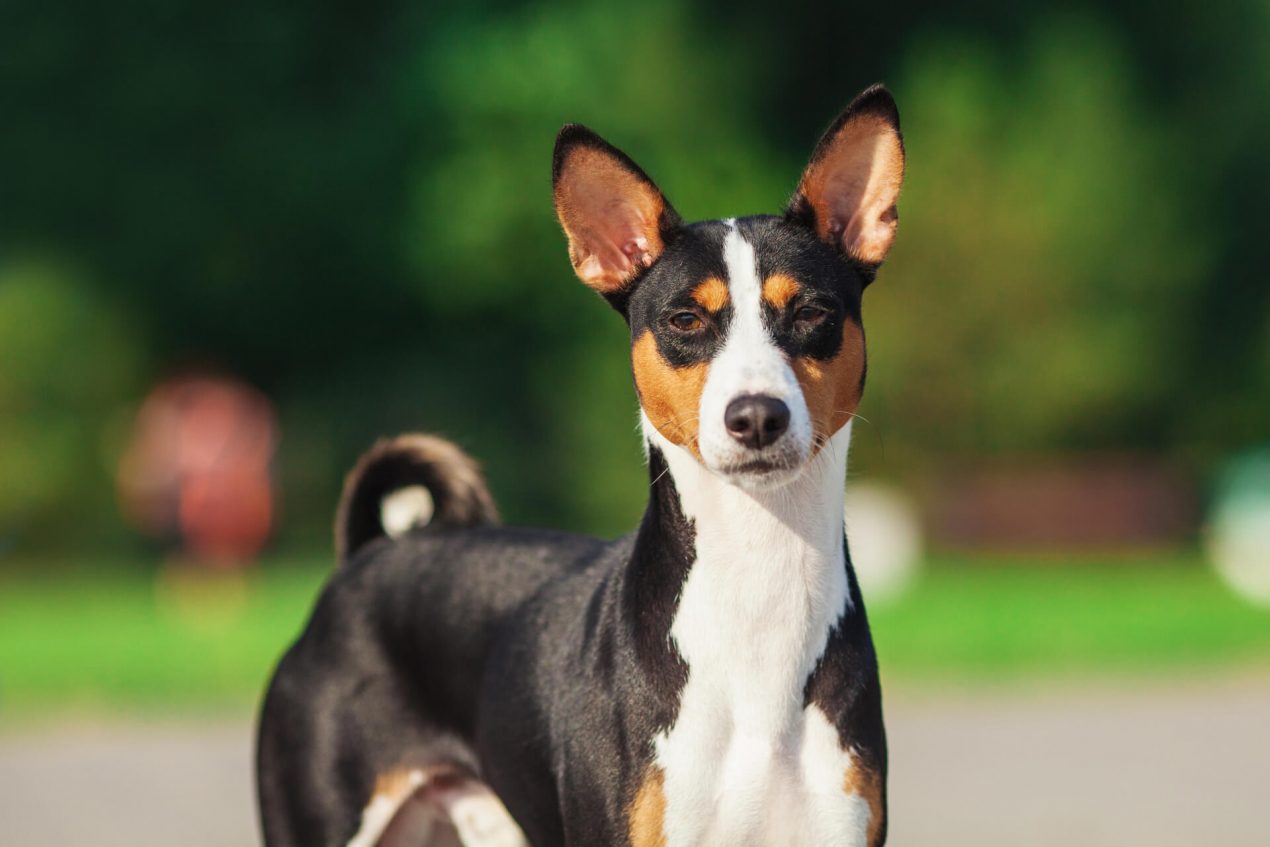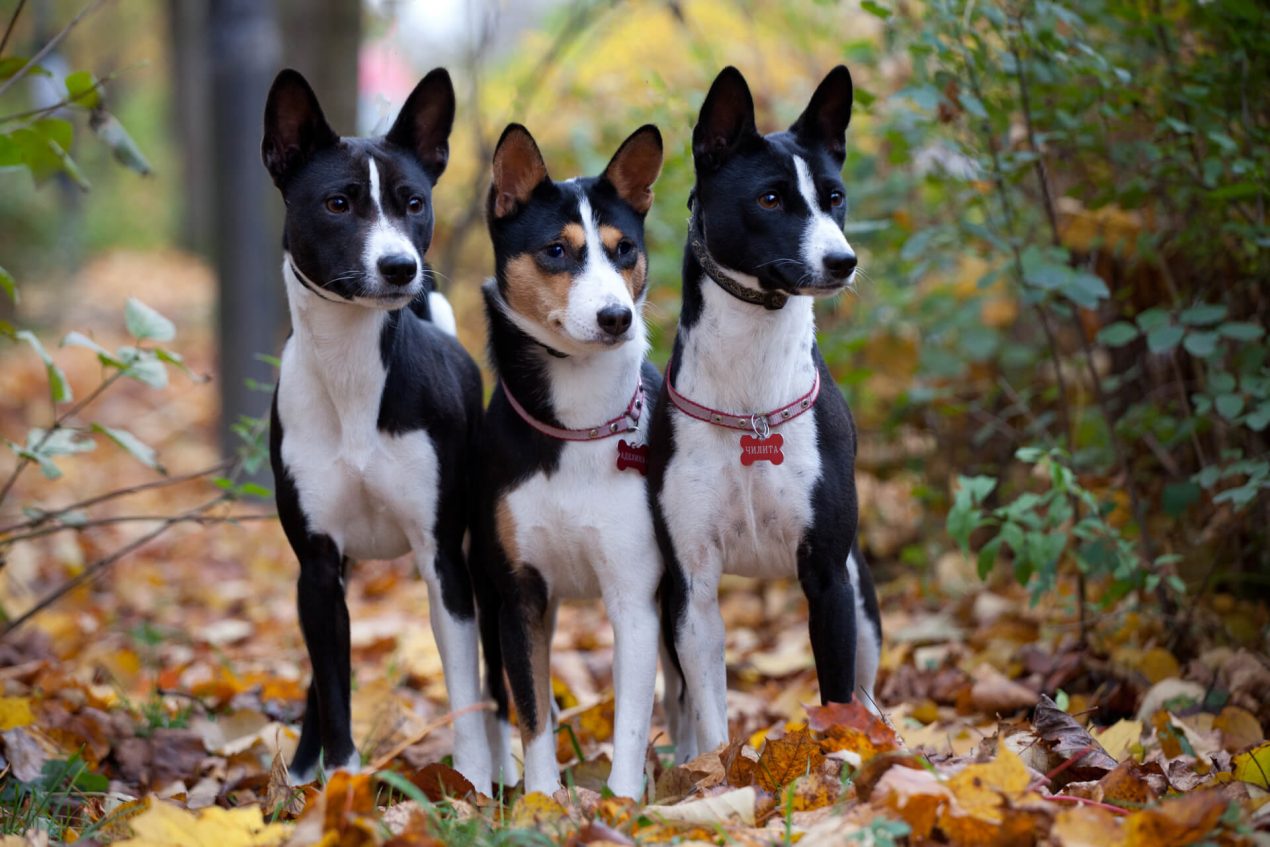The Basenji, affectionately called “Bongo,” is an ancient breed from the jungles of Central Africa. These independent dogs differ in many ways from the breeds we are familiar with. In this profile, you’ll get information about the history, care, and grooming of these unique companion dogs.
History of the Basenji
Due to the lack of records, little is known about the origin of the Basenji. It is classified as a primitive breed. Researchers believe it descends from the ancient Egyptian Tesem. Descendants of these dogs, known as Pariah dogs, still live semi-wild in African villages. They have no direct contact with humans and are not pets. However, in the rainforests of the Congo Basin, some of these agile dogs served the Pygmy people as guard and hunting dogs. The term “Basenji” comes from the language of the Pygmies and means “little wild thing from the bush.”
In 1870, British colonialists discovered these dogs and called them “Congo Terriers.” Olivia Burn, the wife of a British colonialist, is considered the first breeder in Europe. In the 1930s, the British established a breed standard and began showing the dogs at exhibitions. Official recognition by the FCI occurred in 1964. Today, these dogs belong to FCI Group 5 “Spitz and Primitive Types,” in Section 6 “Primitive Type.” Basenjis didn’t make their way to the United States until the early 1900s, and breeding efforts started gradually. Although the American Kennel Club acknowledged the breed in 1944, it remains relatively uncommon in North America.
Breed Overview
GROUP: Hound
HEIGHT: 16 inches (female), 17 inches (male)
WEIGHT: 22 pounds (female), 24 pounds (male)
COAT: Short, smooth
COAT COLOR: Black and white; black, tan, and white; brindle and white; or red and white with/without brindle markings
LIFE SPAN: 13 to 14 years
TEMPERAMENT: Independent, intelligent, quiet
HYPOALLERGENIC: Yes
ORIGIN: Democratic Republic of the Congo
Nature and Character
The Basenji is an independent and intelligent dog that attentively observes the world. On the one hand, it is reserved and cautious, and it can be shy around strangers. However, in its familiar environment, the African dog is calm and generally composed. Due to its pronounced independence, the spirited dog tends to roam. Its nature is generally more comparable to that of a cat. It has a strong hunting instinct and is a social pack animal. It gets along best with other Basenjis but also with other dogs. Its humans can also take on the role of the pack. Consequently, these dogs dislike being alone at home. With proper socialization and acclimatization from puppyhood, they can also live with cats.
| Affection Level | Medium |
| Friendliness | Medium |
| Kid-Friendly | Medium |
| Pet-Friendly | Medium |
| Exercise Needs | High |
| Playfulness | Medium |
| Energy Level | High |
| Trainability | Low |
| Intelligence | Medium |
| Tendency to Bark | Low |
| Amount of Shedding | Low |
Appearance of the Basenji
The Basenji is a lightly built, medium-sized dog. Its proportions are harmonious, giving it an elegant and graceful appearance. Its legs are long compared to its body, and its gait is smooth. The tail is tightly curled and lies flat on the back. It proudly carries its head high. The skin on its forehead and sides of the head forms characteristic, fine wrinkles. The dark eyes are almond-shaped and set obliquely. The distinctive erect ears are set high and pointed. The dog’s coat is short and lies close to the body. It can come in colors such as black and white, red and white, tricolor, and brindle.

Training of the Puppy
African dogs are relatively stubborn and independent, making their training quite demanding. These confident dogs initially try to assert themselves and prioritize their own needs. Successful training is achieved through mutual trust and clear rules. Especially in the early years, patience with the Basenji is essential. However, do not give up, and work with consistency in training. Consider it a challenge to convince the dog of your leadership.
Activities with the Basenji
The lively Bongo is not a dog for demanding dog sports. Nevertheless, it requires plenty of exercise and engaging activities. It loves to run around in nature and can become exceptionally fast. Since many Basenjis are not fans of recall commands, you should only unleash them to a limited extent. Fetch games are also not their thing if they don’t see the point in them. Despite this, these agile dogs are excellent athletic companions. They can easily keep pace while jogging or cycling. Long walks are part of their routine, although they prefer to avoid bad weather. Additionally, they tend to avoid water and are not enthusiastic swimmers. Although the breed is athletic and lively, the Bongo also enjoys lounging with its pack in the house.

Health and Grooming
Basenjis are clean and tidy dogs that require minimal grooming. They do not have a strong odor and shed very little hair. Some members of the breed even groom themselves like cats. Since these dogs come from a tropical country, they are relatively sensitive to cold. Therefore, a dog coat, but not a costume, is recommended in bad weather and cold temperatures. Due to selective breeding, some genetic defects occur in the breed. Highly overbred representatives of the breed are predisposed to eye diseases and metabolic issues. However, reputable breeding programs work to combat such hereditary diseases.
Is the Basenji Right for Me?
The Basenji is a special breed of dog that differs in many ways from others. Its independent nature makes the training of this African dog somewhat more complicated. Therefore, this proud and elegant dog belongs in the hands of an experienced owner. These dogs also feel comfortable in city apartments if they get enough exercise. They enjoy living with other dogs. Generally, the Bongo is only recommended for people who have the time and desire to seriously engage with the peculiarities of the breed.

You can get a purebred puppy from a breeder affiliated with the 1st Basenji Club America in the AKC. Expect to pay around $1200 for a healthy puppy. Pay particular attention to ensure that the parent animals are not show dogs. Also, the breeder should openly and honestly inform you about possible hereditary diseases. Occasionally, you can find representatives of the breed or mixed breeds looking for a new home in animal shelters.
Interesting and Worth Knowing
The Basenji’s bark is as unique as the rest of the dog. It rarely makes a sound, but when it does, it resembles more of a yodel or howl. In the 1956 film “Goodbye, My Lady,” its bark is featured. A boy finds a dog that, instead of barking, yodels and laughs. The female dog “My Lady of the Congo” from England played a role in the film as an animal actor. The breed was relatively unknown at that time. Thanks to the film, it became increasingly popular, especially in the USA.
Do you have a Basenji or are you planning to get one? Share with us in the comments what makes it special in your opinion!


